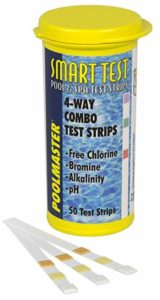How to Clear Cloudy Pool Water
Maintaining your pool is usually pretty straight-forward, but sometimes you have to deal with that frustrating problem of cloudy pool water. This is usually an alert that something is not right with your pool. It is not only uninviting but it is potentially a safety hazard because the water is not properly sanitized. Determining what exactly is making your pool water cloudy is the first and probably most difficult step of resolving this issue. The first thing you want to check for is if there is algae visible on your pool walls for floor? If not, skip to the section Why is My Pool Cloudy? to determine what is causing the cloudiness.
How to Remove Algae From your Pool
If algae is visible along the walls or on the steps of your pool, follow these steps to remove the algae. This alone may clear up the cloudiness and resolve your issue.
 Step 1: Vacuum and brush the pool walls and floor thoroughly
Step 1: Vacuum and brush the pool walls and floor thoroughly
Step 2: Add a chlorine-based pool shock like this one with the pool filter system running (check with manufacturers recommendation for amount to kill algae). Pool filter system should be running 24 hours/day. Learn more about how to shock your pool.
Step 3: If algae has not cleared within 12-24 hours, add a second dose of pool shock. Repeat until algae is dead.
Step 4: Remove the algae from the pool with another round of vacuuming.
If you have removed all of the algae from your pool and the water is still cloudy, there is a greater issue to be dealt with.
Why is My Pool Cloudy?
There are a number of reasons that could cause your pool to be cloudy, which is why it can be difficult to pin point the cause and fix it.
- Check your Filter: make sure it is clean, filtering properly and that it is running for the recommended amount of time each day (8-12 hours). Also check that the filter you are using is not too small for your pool.
- Check your Pump: ensure that it is working properly, clean or backwash the pump (whatever is recommended by your manufacturer) and that your pump is the right size for your pool.
- Make sure your pool is circulating properly but aiming your returns downward in a synchronized position so that the water flows in a circular manner.
- Ask yourself if you are shocking and vacuuming your pool regularly and properly. If you are unsure if you are vacuuming your pool properly, head over and read our article about how to use a pool vacuum.
If you have determined the pump is too small or too big for your pool, consider purchasing a new pump. If your water is not circulating appropriately, consider adding a robotic pool vacuum, such as this one, for less manual maintenance. If you have confirmed that your pump and filter are the adequate size for your pool, they are functioning properly and you are vacuuming your pool regularly, then it is likely that your pool cloudiness is a result of a chemical imbalance.
Testing Your Pool Water
Purchase an at-home testing kit like this one to check levels for the following:
- Free Chlorine: 1-3 ppm
- Combined Chlorine should be zero
- Total Alkalinity (TA): usually 90-120 ppm
- Calcium Hardness (CH): 200-350 ppm
How to Clear A Cloudy Pool
If you have determined that any of the previously mentioned chemical levels are off, you will need to adjust the chemicals in your pool to balance them out. If your pH or TA levels are too high, you may need a pH reducer to bring your levels back down. If the CH is high, try reducing the amount of calcium-based chlorine that you are using. After adjusting the chemicals, run the pool filter system and re-test again in 12-24 hours. If your pool is still cloudy, try adding a pool clarifier chemical to enable your filter to remove the fine debris, keeping your filter running and check for improvement. This may require a few cycles, but be careful not to use too much clarifier or it could have adverse effects.

If you are still having issues with pool water cloudiness, you should consider consulting a pool professional that can test and resolve the problem. Until then, it is strongly encouraged to stay out of the water as it can potentially be harmful.


